5 Differences Between Iranian and California Pistachios
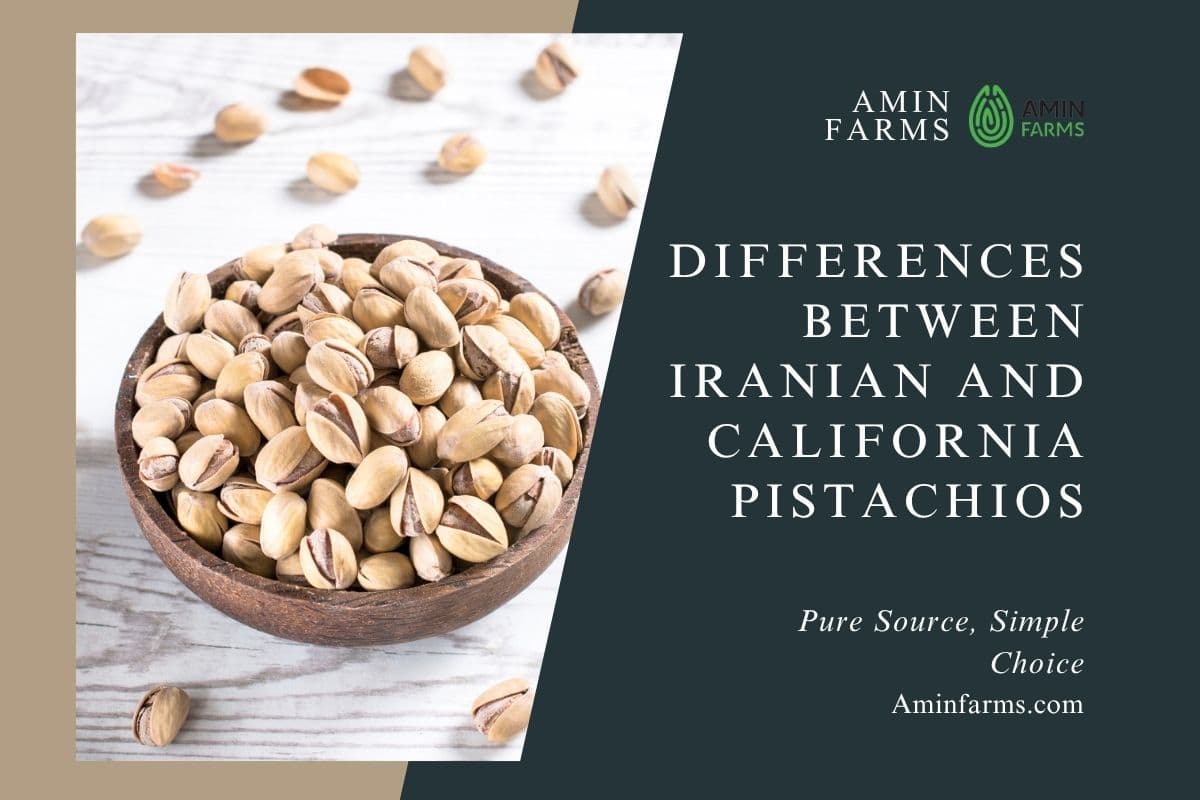
Pistachios are a global commodity with an ancient history, far more significant than just a snack. The market is defined by a rivalry between two titans: Iranian pistachios, celebrated for their rich, deep flavour, and California pistachios, known for modern uniformity and technology.
This intense competition between Iran and California pistachios naturally prompts a key question for consumers and traders: Which variety is truly superior?
This comprehensive article offers an in-depth comparison to highlight the precise difference between Iranian and California pistachios. Our exploration begins with a flavour face-off, analyzing how cultivation affects taste, and extends to crucial physical traits such as size and shape.
We then compare nutritional profiles, global pricing, and distinct farming practices. By thoroughly investigating every key difference between Iranian and California pistachios, you will gain the knowledge necessary to make the best, most informed choice for your needs in 2025.
Flavour Face-Off: Iranian vs. California Pistachios

For many seasoned pistachio lovers, flavour is the key difference between Iranian and California pistachios. Pistachios are profoundly shaped by their homeland, the soil, the sun, and the way they’re grown.
On one side, you have Iranian pistachios, heirs to centuries of cultivation in Iran’s warm, arid lands. They’re famous for their richer, more buttery taste and dense, oil-rich kernels. Experts often call their sweet, complex notes the gold standard of pistachio flavour.
Across the ocean, California pistachios tell a different story. Mainly produced from a single variety, the Kerman, they offer a lighter, slightly sweeter, and more uniform flavour profile, perfect for snacks and food products where balance matters.
So, when it comes to Iran vs. California pistachios, it’s a choice between depth and consistency, heritage and precision —and ultimately, it all comes down to your personal taste.
Taste Profiles and Cultivation Impacts
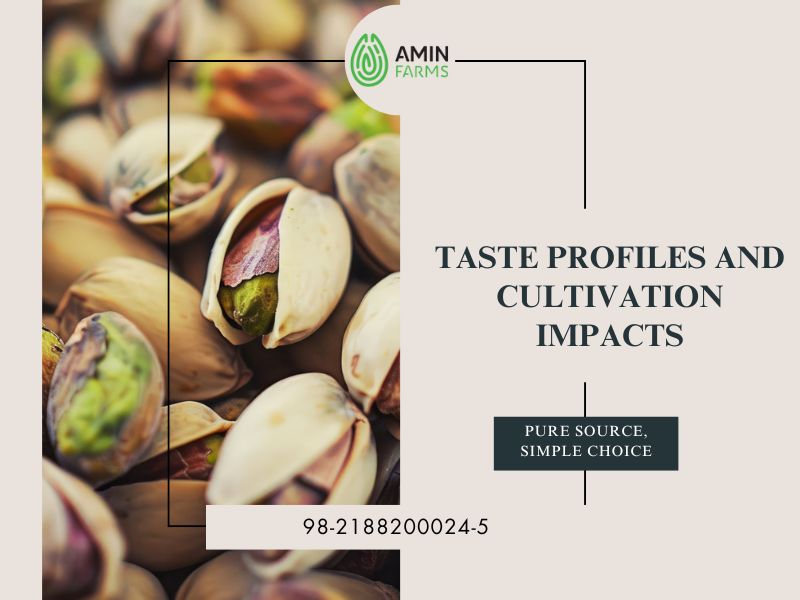
The unique flavour of Iranian pistachios comes from their rich genetic diversity, varieties like Ahmad Aghaei, Fandoghi, and Akbari, and the country’s desert climate. Grown under long, hot summers and cool nights, these nuts develop higher levels of unsaturated oils, creating that buttery, intense flavour people love.
Traditional irrigation and orchard care further preserve their natural depth, while roasting brings out even more of their signature richness.
On the other hand, California pistachios are almost entirely produced from a single variety, Kerman, which originated in Iran. Cultivated in large, efficiently irrigated orchards with modern machinery, they offer a sweeter, more consistent flavour and uniform size. In the food industry, balance and reliability are key.
Ultimately, the difference between Iranian and California pistachios lies in genetics, farming practices, and environment —the essence of what defines Iran vs. California pistachios today.
Size and Shape Showdown Between Varieties
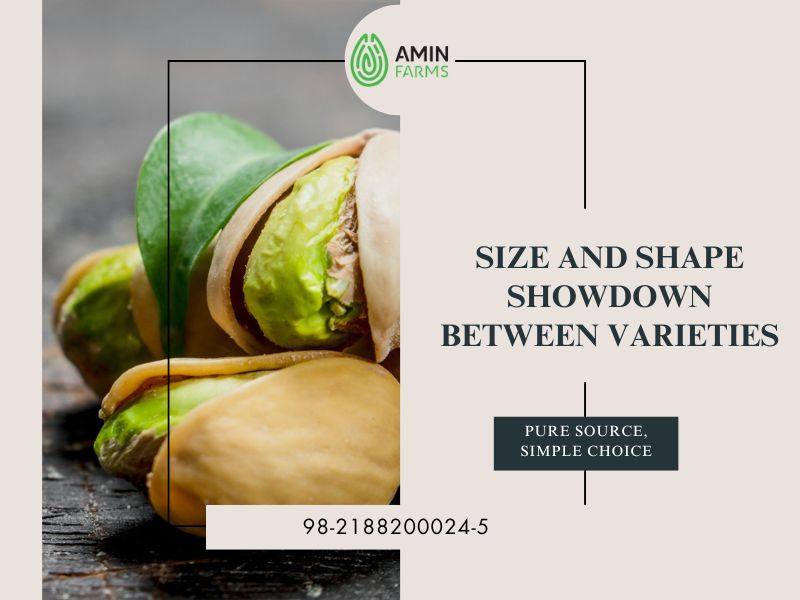
Beyond taste, the difference between Iranian and California pistachios is clearly visible in their size, shape, and shell appearance. These physical traits not only affect how pistachios look and open, but also determine how they’re used, whether for snacking, confectionery, or large-scale processing.
Iranian pistachios come in many shapes and sizes: Akbari (long), Ahmad Aghaei (almond-shaped), and Fandoghi (round). This natural diversity gives them a wide range of visual options. They’re also known for a higher percentage of naturally open shells, the famous smiling pistachios prized in global markets.
In contrast, California pistachios, almost entirely from the Kerman variety, are larger, rounder, and more uniform. Their shells are smooth and pale tan, rarely needing bleaching. So, when it comes to Iran vs. California pistachios, the choice is between character and consistency, between tradition’s beauty and modern precision.
Why Iranian Pistachios Often Win on Openness?
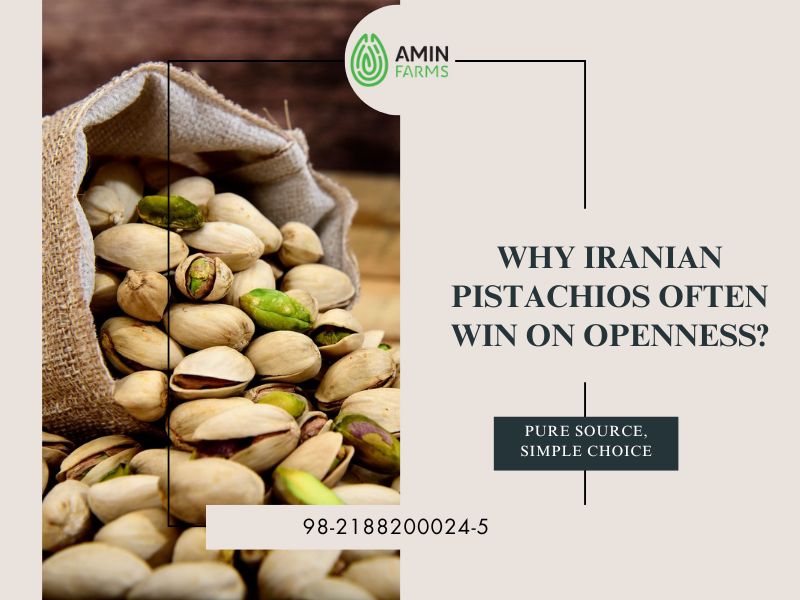
Among all the qualities that set pistachios apart, few are as visually and commercially important as how naturally their shells open. This single trait defines texture, quality, and even the joy of cracking them open.
Iranian pistachios are globally prized for their high percentage of naturally open shells, known as smiling pistachios. At the same time, California varieties often rely on mechanical processes to achieve the same look. Here’s what truly shapes this difference between Iranian and California pistachios:
- Ripening Time: Iranian farmers, guided by centuries of experience, harvest precisely when the pistachio reaches full maturity and the shell splits naturally.
- Climate Conditions: Long, hot days and cool desert nights in Iran encourage full kernel development and natural shell opening.
- Genetic Variety: Cultivars like Fandoghi and Akbari are genetically inclined to open wider, giving them their signature “smile.”
- Irrigation Methods: Traditional, less-intensive watering creates natural stress that promotes healthy splitting, unlike California’s controlled, steady irrigation.
- Processing Style: In large-scale U.S. farms, closed-shell pistachios are mechanically opened or heat-treated. Iranian exports, in contrast, focus on naturally open nuts, a mark of authenticity and premium quality.
In short, when comparing Iran vs California pistachios, Iran’s secret lies in nature itself, not machinery.
Nutritional Breakdown: Iranian or California?
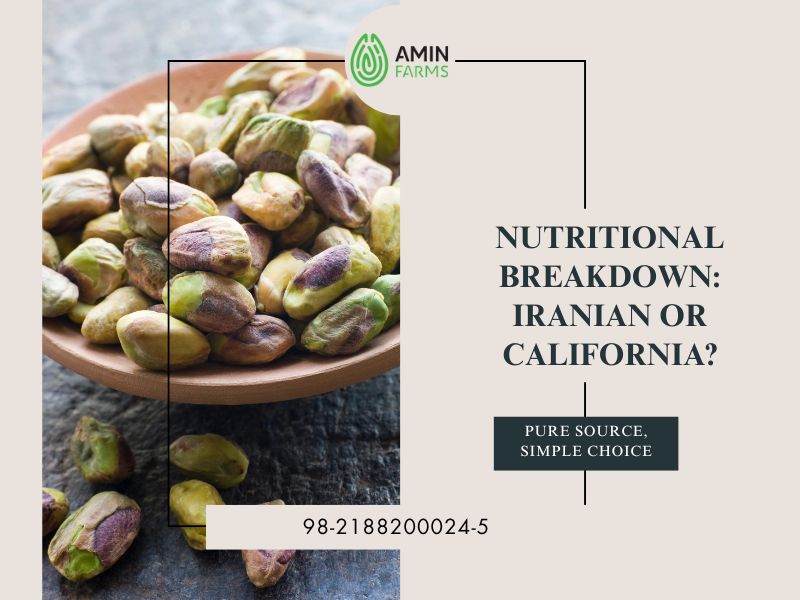
Forget the simplistic labels; pistachios, irrespective of their sun-drenched origins, are truly nature’s miniature health vaults—brimming with protein, fibre, beneficial fats, and essential antioxidants. Yet a careful examination of their chemical composition reveals a subtle yet significant difference between Iranian and California pistachios.
The ancient terroir of Iran coaxes a unique richness from its kernels. Consequently, Iranian pistachios naturally possess a slightly elevated oil content. This lipid boost isn’t merely about caloric density; it’s the secret behind their intensely buttery flavour, fueled predominantly by heart-loving monounsaturated fats.
Across the Pacific, the standardized California pistachios often present a profile neatly tailored for modern nutritional metrics, sometimes delivering a fractional edge in protein and fibre per serving.
Ultimately, whether your palate prefers the earthy heritage driving the Iran vs California pistachios debate or the precision of industrial agriculture, both global players deliver spectacular, satisfying nutrition in every single crunch.
Price and Availability in Global Markets
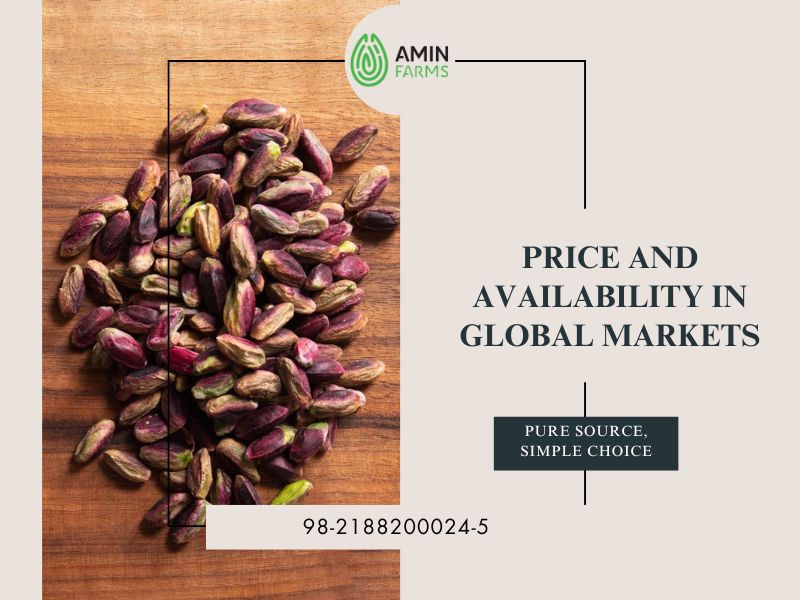
The pistachio rivalry goes far beyond taste and texture; it’s also about price stability and global reach. The difference between Iranian and California pistachios becomes especially clear in international trade.
California pistachios, supported by large-scale production and advanced logistics, offer consistency and dependable pricing across U.S. and European markets. Their prices, though influenced by weather, remain relatively stable and less exposed to currency swings.
Iranian pistachios, prized for their premium flavour and craftsmanship, often command higher prices but face challenges from sanctions, exchange-rate fluctuations, and logistics. Still, in Asia and the Middle East, they maintain a loyal market built on trust and tradition.
In short, the Iran vs California pistachios story is one of trade-offs; California delivers a steady supply, while Iran offers unmatched character at a more dynamic price point.
Environmental and Farming Differences

Agricultural management in Iran and California follows two fundamentally different paths, each indelibly shaping the land and the pistachio kernel itself. This dichotomy highlights the profound difference between Iranian and California pistachios.
California’s system is a marvel of industrial precision, highly mechanized and engineered for maximum efficiency. Its approach is defined by precision irrigation, sophisticated pest control, and rigid quality standards. While this guarantees consistent, uniform output, the sheer scale still means heavy water use.
In contrast, Iran’s pistachios are deeply rooted in centuries of tradition. Iranian trees exhibit remarkable genetic resilience to saline water and the punishing aridity of the climate. Yet, reliance on older irrigation methods presents immediate environmental challenges.
Ultimately, the genuine Iran vs California pistachios story is one of philosophy: California champions science and industrial consistency, whereas Iran relies on time-tested sustainability and climatic wisdom.
Which Pistachio Fits Your Needs in 2025?
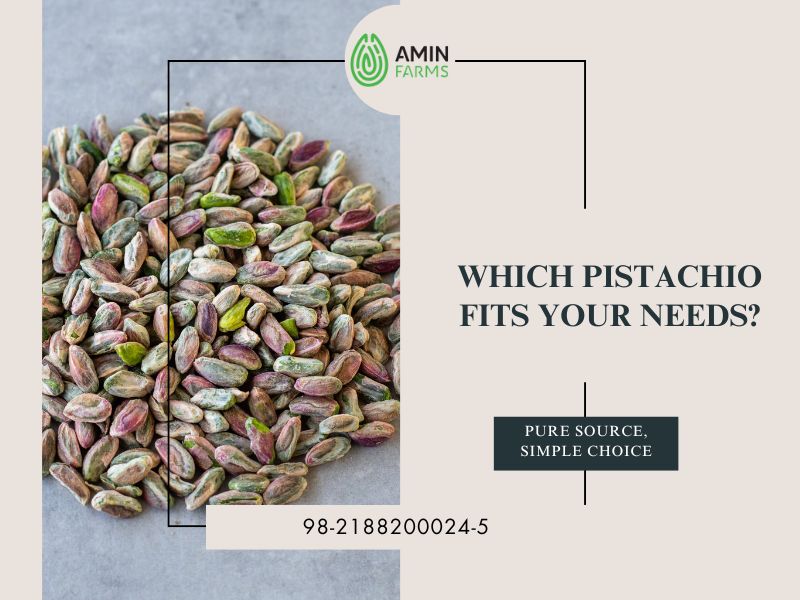
Choosing between these two pistachio powerhouses depends on what you value most in the difference between Iranian and California pistachios.
Suppose you seek reliability, consistent size, and a stable year-round supply. In that case, California pistachios are your best choice, engineered for industrial-scale and commercial use. But if you desire deep, complex flavour and naturally distinctive shapes born from heritage farming, Iranian pistachios remain unmatched. Their taste tells a story of climate, culture, and care.
For those looking for premium quality, Amin Farms stands among Iran’s leading suppliers, known for delivering top-grade pistachios that embody the authentic excellence of Iranian agriculture.
Each nut reflects generations of craftsmanship, sustainable cultivation, and an enduring passion for quality that continues to set Iranian pistachios apart worldwide.



